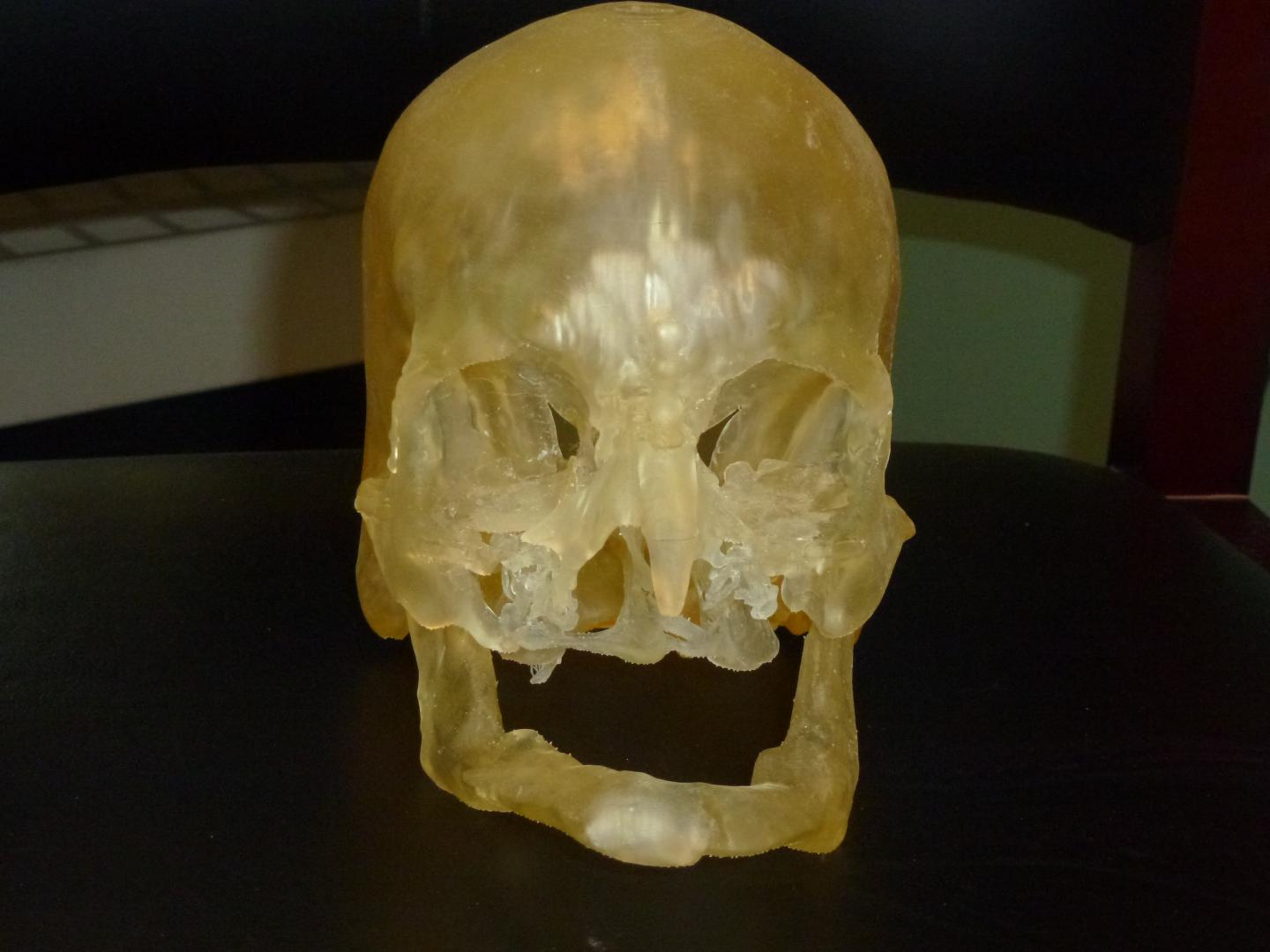Surgeon's Helper: 3D Printing Is Revolutionizing Health Care (Op-Ed)


Scott Dunham is a senior analyst for SmarTech Markets Publishing, which focuses exclusively on additive manufacturing and 3D printing. Dunham is a regularly featured speaker at 3D printing industry events worldwide, and he will be presenting at the Additive Disruption Summit on April 1 and the RAPID conference on May 19. He contributed this article to Live Science's Expert Voices: Op-Ed & Insights.
Health care is a constant topic of debate today — but health care is not all about politics. Innovations in treatment and technology are revolutionizing how we care for one another, though there are still practices that are remarkably outdated or fall short of the goal of improving, or saving, lives. Now, with the rapid evolution of additive fabrication — the increasingly popular technologies often referred to as 3D printers — the future of health care is advancing in ways both familiar and dramatically new.
While makers of professional 3D printers are specifically developing, and promoting, dental uses for 3D-printed technology, the universe of non-dental medical applications is now entering a phase of rapid growth.
3D printing: A model of personalized medicine
In the context of manufacturing, 3D printing for medical applications is actually quite unique when compared to other popular industries such as aerospace, automotive and others. Why? The obvious answer is the human element present in all health care applications, where often cost becomes a secondary concern to a successful outcome that saves a life or greatly improves the quality of one. [7 Cool Uses of 3D Printing in Medicine ]
But we recently produced a 10-year forecast for the field, and there is an unusually strong synergy among digital 3D design, medical imaging and 3D printing for medical applications. The three form a trifecta of medical problem-solving power, where physicians can use patient-specific data to capture, manipulate and ultimately apply physical solutions of all shapes and sizes through 3D printing. Without such technology, personalized medicine would be difficult, as patients will need unique parts that can be rapidly and simply manufactured.
There are two especially interesting areas where 3D printing has the potential to impact millions of lives through a variety of revolutionary medical solutions: surgery and the treatment of otherwise intractable health conditions.
Get the world’s most fascinating discoveries delivered straight to your inbox.
Revolutionizing surgical practice
In today's operating rooms, 3D-printed applications in the operating room are generally limited to a relatively small number of procedure types, though physicians can easily apply the lessons from one surgery to many others. For example, pioneering case studies in the use of printed 3D medical models are rapidly increasing interest and use of the technology in cases such as 2-year-old Mina Khan and the cardiac model that allowed surgeons to build a custom implant to patch a defect in the ventricles of her heart.
Surgeons are finding that 3D-printing technology can reduce operating time, lower risks from errors or complications, and produce better outcomes for patients through the use of 3D-printed surgical models and tools — this is apparent in recent efforts to perform face transplants, for example.
Professional 3D printers now incorporate photo-curable resins of various textures, transparency and flexibility — so before procedures, surgeons can now plan complex surgeries with CT scan data of a patient's bones, blood vessels or other organs, converted to a 3D-printable digital file that can be manipulated and studied. And for operations involving cutting or drilling into skeletal structures — such as jaw surgeries, knee replacements and other joint-related procedures — 3D printing is also creating the perfect fit through printed custom guides and tools.
Using medical imaging and 3D-modeling technology, doctors can now also use 3D printers to create temporary tools that are affixed to the skeletal structure of the patient to provide a precise "blueprint" for reshaping bone structure to perfectly accommodate standard-size implants. Custom-printed drilling guides ensure that screws are placed precisely to ensure the best fit with a patient's body.
In 10 years, it's highly likely that 3D-printed medical models and custom surgical guides will be standard procedure for a variety of operations, including heart surgery, jaw surgery, knee replacements, hip replacements, cranial implants, shoulder operations, spinal procedures and many others.
Bringing treatment to the untreatable
One of the most inspiring outcomes from the rapid expansion of 3D-printed medical solutions is the ability to help patients who previously had little hope for treatment. Whether due to financial obstacles or the unique circumstances of a condition, millions of people across the globe are unable to undergo critical surgeries. Now, in some cases, 3D printing is helping remove those obstacles.
One particularly fantastic example is in the case of prosthetic hands and transradial (below the elbow) prosthetics. The need for such prosthetics, in relation to the total market value, just doesn't add up for most medical device companies. Traditional transradial prosthetics are extremely expensive: usually $10,000 to $20,000 or more per device. The prosthetics can degrade from extensive use, and if the patient is young and still growing, a prosthetic solution simply isn't practical — especially if the patient has another fully functional limb to fall back on. Tens of thousands, if not hundreds of thousands, of people who could live measurably better lives with a transradial prosthetic simply don't have a viable solution. [3-D Printed Material Mimics Biological Tissue]
But 3D printing is changing this — and quickly.
In the last two years, there has been a revolution in the number of completely customizable, functional prosthetic hands that can be printed by even the most inexpensive 3D printers. Total cost (including materials) for these is often less than a few hundred dollars, as volunteer communities such as e-Nable connect those with printers and experience to those in need of a prosthetic.
Even for people who don't own a printer, functional prosthetic hands have suddenly become a possibility — including children who would otherwise have struggled through childhood, as kids outgrow prosthetics in just months. Now, someone with a printer can print a child's new device in fewer than 24 hours. And, prosthetics can incorporate custom designs unique to each patient. A number of very happy children are currently using hands modeled after their favorite superheroes.
3D-printable implants of the hip and spine, while still a very small portion of the overall market for implants, are another great example of how the technology can bring treatments to people who may have been considered untreatable.
Specialty medical-implant providers are using industrial printers to create custom implants for patients who would be otherwise have great difficulty finding a traditional implant solution. The aging population continues to get heavier, and it isn't uncommon for people with bad hips and knees to have second or even third procedures as their bodies — and traditional implants — degrade. Specialty implants fabricated through 3D printing are often the only way to treat some of these patients with any hope of long-term success.
What's next?
In addition to proven solutions like models, surgical guides and implants, engineers are also exploring approaches that are much more experimental, but with the potential for life-changing consequences.
The status quo for fracture braces has been largely unchallenged for decades. The traditional fiberglass wrap requires specialists and significantly impacts everyday life because of its bulky design and restrictions for staying dry. That could soon be challenged by elegant, 3D-printable braces that can be snapped on and off in seconds, while allowing skin to breathe so it doesn't decompose, as with a traditional Fiberglass wrap. The ability to easily and quickly put on or remove the brace eliminates 90 percent of the appointment time a fracture patient spends with a specialist, saving on overall costs. And, the slim, form-fitting design allows the wearer much more freedom to carry on normal life while healing from injury.
Some 3D printable healthcare solutions are still a work in progress. While transradial prosthetics for the hand are taking off, prosthetics for leg amputees still pose significant 3D printing challenges: Most easily available printers and print materials simply can’t withstand the constant loading leg prosthetics require. Custom-made 3D printed "fairings" — essentially an aesthetic enhancement to a traditional metal leg prosthetic — are about the only area 3D printing has been able to improve for leg prostheses. But the potential for future innovations in these, and other, areas is growing. [The 10 Weirdest Things Created By 3D Printing ]
It is this willingness of innovators in medical design to think outside the norm with 3D printing is fueling the engine of change in health care. 3D-printed medical applications, whether in the most experimental of phases or on the brink of revolutionizing traditional medical practice, are all about three things: The ability to treat more people where it previously was not feasible; better outcomes for patients; and less time required under the direct care of medical specialists. This is the future of health care — 3D printing is enabling doctors to treat more patients, without sacrificing results.
Follow all of the Expert Voices issues and debates — and become part of the discussion — on Facebook, Twitter and Google+. The views expressed are those of the author and do not necessarily reflect the views of the publisher. This version of the article was originally published on Live Science.






